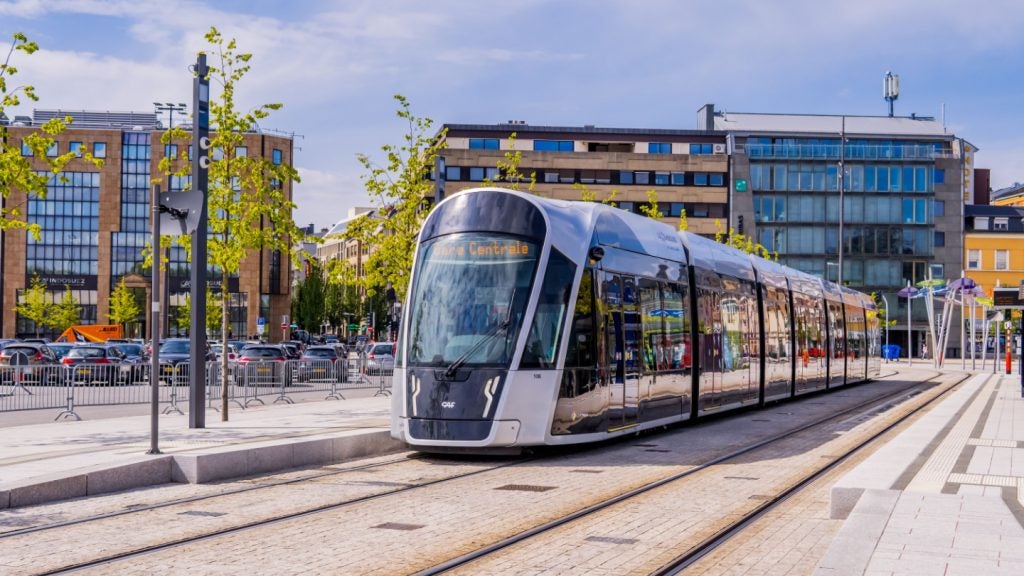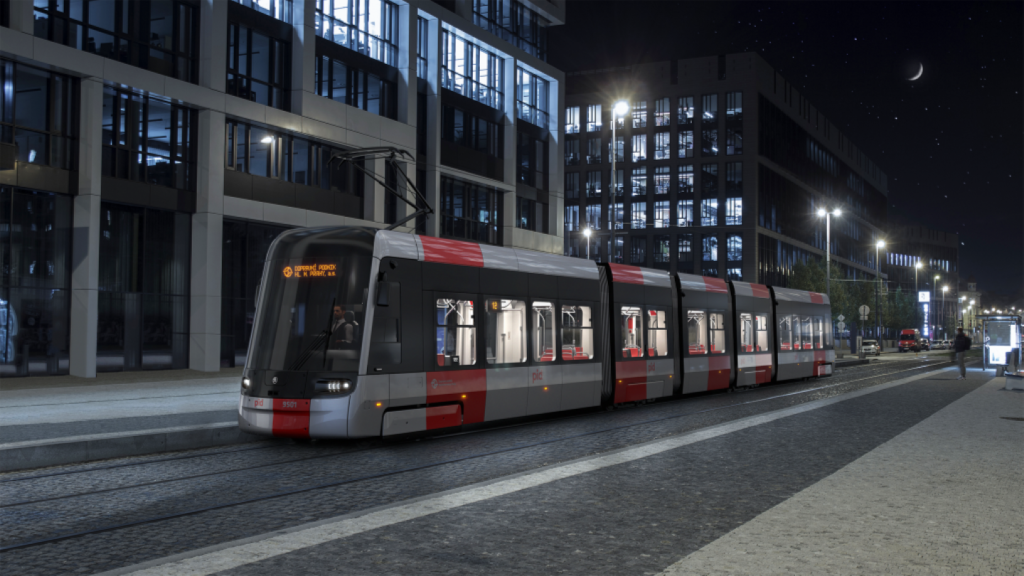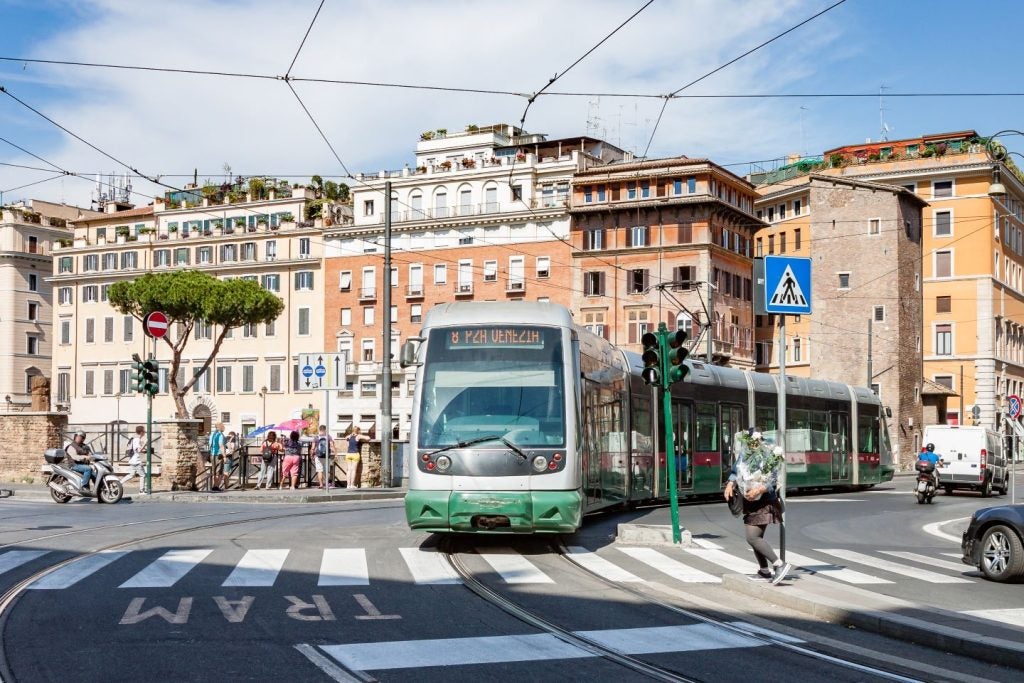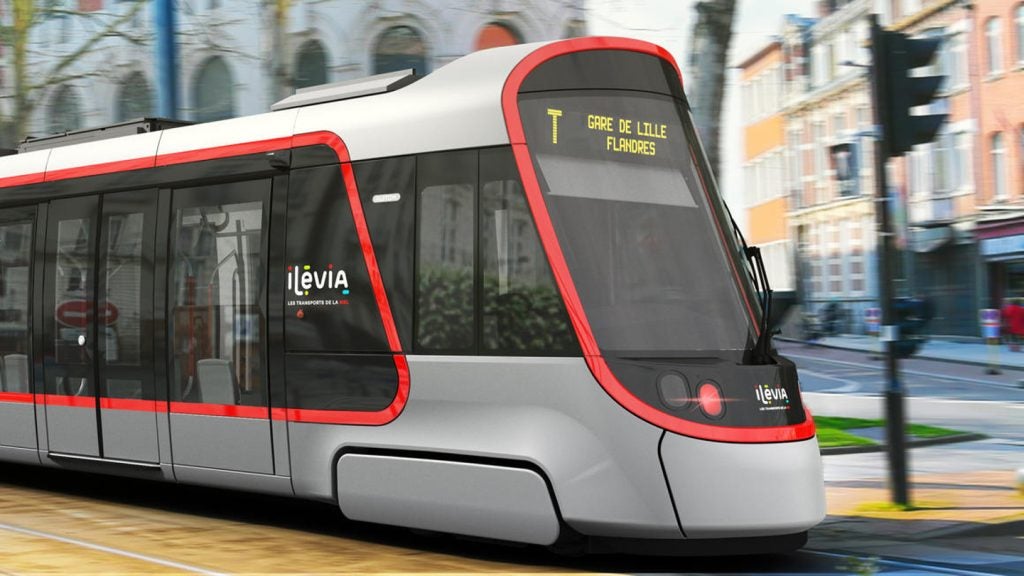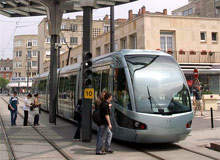
France is a nation synonymous with developments in high-speed rail technology. The train à grande vitesse (TGV), the high-speed steel-wheel rail train developed by Alstom and SNCF, which is also the operator, is a world-leading product that continues to be developed and exported worldwide.
But just as rapidly as high-speed rail came to grip the nation, France moved from being almost devoid of tramways to becoming a showcase of the international light rail industry.
20TH CENTURY TRAMWAY DECLINE
In common with many European countries, France saw most of its original tramway networks decline and close through much of the 20th century. Increased prosperity, improved routes nationales (trunk roads) and the expanding autoroute (motorway) network encouraged private car ownership.
Improved bus fleets providing quicker and cheaper urban public transport also affected France’s tram lines and for a while. Apart from three surviving fragments – Lille, Marseilles and St Etienne – France seemed finished with light rail.
In 1977 work on the cross-city urban rail RER subway network and the Paris Metro was extended. Lyons followed by opening a conventional metro in 1978 and Lille introduced the driverless, rubber-tyred VAL (véhicule automatique léger – automatic light vehicle) system in 1983.
But in spite of the decline of light rail, larger French cities still had to address the need to move large masses of people around, without total reliance upon increasingly crowded roads. So work continued, with unexpected affects, on French tram networks.
How well do you really know your competitors?
Access the most comprehensive Company Profiles on the market, powered by GlobalData. Save hours of research. Gain competitive edge.

Thank you!
Your download email will arrive shortly
Not ready to buy yet? Download a free sample
We are confident about the unique quality of our Company Profiles. However, we want you to make the most beneficial decision for your business, so we offer a free sample that you can download by submitting the below form
By GlobalDataThese urban areas, which were much smaller, and Marseilles kept their tram lines running as a way of providing a much less expensive public transport option to the people, while at the same time, advancing the way light rail would run.
FRENCH LIGHT RAIL – BEYOND THE GRAVE
By the 1980s, a number of factors converged in a way that was to lead to light rail becoming the mainstream response for transporting France’s urban population. With a tradition of centralisation reaching back to the Napoleonic era, it was a cluster of national legislation following the 1982 Urban Mobility Master Plan guidelines that prompted the proliferation of the French tramway systems.
Although not prescriptive about the solutions adopted, the plan de déplacements urbains (PDU or urban travel plan) required all cities – in practice, a cluster of communes – with a population of more than 100,000 to create their own strategy for public transport.
The PDU takes account of such factors as energy use, town planning, land use, traffic levels and access to public transport. It also gave a directive for planning to be revised as necessary for changes in the urban perimeter at five-year intervals.
The early years of the 1980s also saw the national introduction of ‘versement transport‘, an employer payroll tax which was originally deployed in Paris a decade earlier to part-finance the Metro expansion. Although controversial, this dedicated funding stream became crucial to the rapid development of light rail.
It was estimated in a study on behalf of the British Passenger Transport Executive Group in 2004 that the fund for Lyons, for example, which has the same population as Merseyside, was worth about £10m (€14.6m) a year. Teamed with a fiscal planning and approval process that is relatively speedy in comparison to other democratic countries with similarly developed economies, this could only help light-rail grow.
French politics has also had a strong part to play in the nation’s tram success. A high level of civic pride and the mayoral election cycle means the acquisition of show-piece public transport can become a clear and enduring symbol of a successful administration.
Starting out as a promise to an electorate, a new tram route could go from a plan through to operation within a six-year electoral term, leaving it open to further grow into a comprehensive system.
FRENCH TRAM STYLE
The importance of a light rail network as part of a city’s modern identity has been exemplified by the distinctive and specific styling of trams, such as those that operate in Marseilles, Lyons and Strasbourg.
In all these cases the form clearly goes far beyond the basic function – their styling becomes visual shorthand for a particular location.
Although most French light-rail projects encounter opposition in the planning stages (mostly due to value for money, construction disruption, business access and conflicts over which system to adopt) the showcase effect of the pioneer modern systems has created a momentum for more development. In effect, light rail has become a club that more French cities want to join.
Recurring elements that have attracted popular support include a restoration of city centres to pedestrians (as opposed to them being funnelled around roads in vehicles), easier access for those with restricted mobility and urban regeneration. And then, of course, there are the rising environmental concerns.
ALTERNATIVES TO LIGHT RAIL
While France clearly embraced light rail as the principal urban transport mode (other than buses) by the start of the 21st century, other approaches have found favour.
In Lille, a growing VAL metro system effectively confined trams to the historic metre-gauge ‘Mongy‘ (named after original engineer) routes to Roubaix and Tourcoing. And Rennes, the Breton capital, is one of the smallest cities in the world to have a metro – its single 9.4km VAL line opened in 2002.
For many years, the presence of a metro in Paris, Marseilles and Lyons meant that the case for surface trams was less pressing. However, these three authorities have subsequently added light rail to their portfolio of public transport services.
Proprietary guided light transit / bus systems have been promoted as offering some of the key benefits associated with modern trams in terms of style, predictable operation and comfort – all at a lower capital cost and in a shorter time than light rail.
Several French cities have taken the opposite route and opted for guided buses, including Clermont-Ferrand and Caen, but it looks as if some established tram operators Rouen and Nantes also seem set to add this mode.
Like Caen, Nancy in eastern France uses the Bombardier transport sur voie réservée (TVR) system – a rubber-tyre tramway. But widely reported problems, not least the lower-than-anticipated safe operational speeds, have set back such systems relative to light rail. Bombardier decided not to further promote the system for now but this has not stopped other guided systems from coming under development in other locations around the world.
RUNNING THE FRENCH LIGHT RAIL
Between them, the French systems use permutations of street running, dedicated formations and redeployed heavy rail routes. Many of the new schemes have made tramways a centrepiece to urban restructuring and/or reinvigoration.
With regulation of public transport remaining a feature of France, revision of bus routes to act as feeders to tram services has become the norm. This is in stark contrast to the deregulation seen in the UK where competing modes allow market forces to control pricing and operators to come under attack for transport pollution.
In France, technical innovations have been introduced to overcome objections to charges of visual pollution created by overhead power supply equipment.
Approval for the Bordeaux tramway was dependent upon fitting of a safe, non-visually intrusive power supply in architecturally sensitive parts of the city. To meet this challenge, consortium leader Alstom developed alimentation par le sol (APS), a sub-surface supply of traction current.
APS – THIRD-RAIL TRAM TECHNOLOGY
In operation since 2003, APS features a central third rail made up of 8m-long conducting segments, separated by three metre-long insulating joints and controlled by supply units installed at 22m intervals. The conducting segments are only powered when triggered by radio signals from the system-equipped tram whilst directly overhead.
Despite in-service operating difficulties, with some retro-fitting of overhead equipment in Bordeaux, and the higher expense for installing and operating the infrastructure, APS has found favour elsewhere. Orléans, Reims and Angers have all placed orders for APS on sections of new-build alignments.
Nice had originally envisaged using APS for powering trams across the large historic squares, Place Masséna and Place Garibaldi. A policy change means the city’s Alstom Citadis trams will have roof-fitted, Saft-produced, nickel metal hydride batteries, capable of providing up to 1km of travel at 30km/h.
Alstom is also involved with Dutch company CCM (Centre for Concepts in Mechatronics BV) in researching the application of flywheels as a stored energy source for tram propulsion.
A specially equipped Citadis tram has been tested in normal operating conditions in Rotterdam since 2005. Energy from braking is routed to the roof-mounted flywheel and released via a generator for propulsion when the vehicle restarts. The 30-year projected working life for the system approximates to that expected for new light rail vehicles.
FRANCE’S ROLLING STOCK – GROWING WITH RAIL
France has a long-standing reputation in many fields for technical innovation along with a tradition of supporting the products of native companies – both areas apparent with its tram fleets. However, when the first modern systems were emerging, France had little in the way of light-rail products.
The solitary Marseille Line 68 used Belgian-built PCCs and the re-equipping in Lille was initially with former German Düwag stock before new Italian Pininfarina-designed Breda trams were introduced in 1993. Even the new, high-profile Strasbourg system opened with British-built ABB Eurotrams in 1994.
With this in mind, the response of Alstom (earlier Alsthom and GEC Alsthom) in such a short time to the burgeoning domestic market has been as noteworthy as the proliferation of light rail systems.
Tramway français standard (TFS) vehicles emerged from a development for Nantes, initially high-floor only, and Grenoble, featuring a pioneering partial low-floor layout. Other TFS buyers included Rouen and Paris.
The approximate 80% penetration by Alstom of the domestic market by 2007 is largely due to the success of the later Citadis modular low-floor design. From its operational debut in Montpellier in July 2000, in its many guises and configurations, the Citadis has become the mainstay of French networks and a popular choice of transport authorities around the world.
Alstom’s main competitor on the world stage, Bombardier, has made some inroads to the French light-rail market. In spite of being an early customer of Alstom (then Alsthom), Nantes subsequently ordered the Bombardier Incentro.
The initial supplier to Strasbourg, via a former constituent company, the city’s transport authority conversely went to Alstom for a Citadis with Eurotram-like styling for their later orders. More recently, Bombardier has produced a dramatically styled, nautical themed, five-section variant of their 100% low-floor Flexity Outlook for Marseille’s new system. German rolling stock giant Siemens has yet to penetrate the market.
ROLLING INTO THE FUTURE
In an international context, the proliferation of French systems since Nantes opened the first of the modern networks in 1985 has been remarkable.
With several new projects going live or into advanced planning and a majority of operational systems looking to undergo expansion projects, and the emergence of Alstom Citadis as a world brand in tramway technology, France has taken centre stage for modern light rail.
Restraints on longer-term developments are likely to remain financial and political rather than technical.
Better still, light rail is able to accommodate emerging technologies such as stored and reused energy – consistent with the ecological agenda.
With all this in mind, France in the first decade of the 21st century, could have easily, and unwittingly, become light rail’s biggest laboratory and showroom for the tramways of the future.



